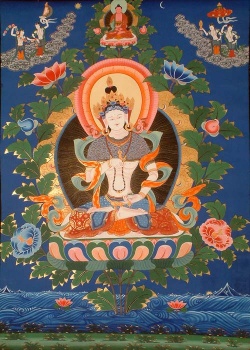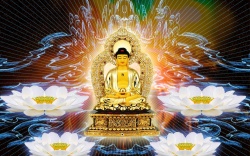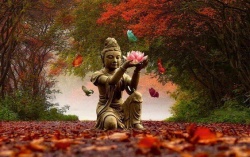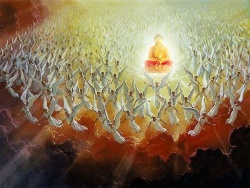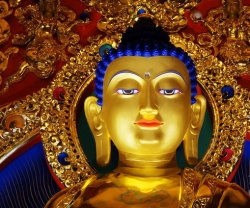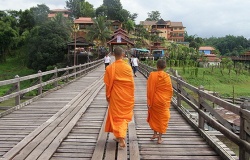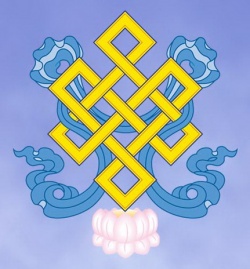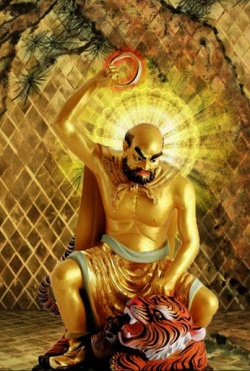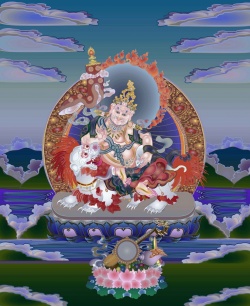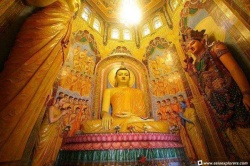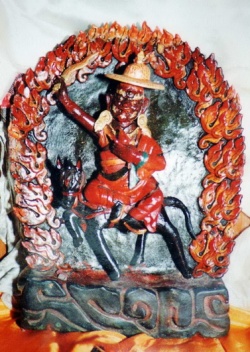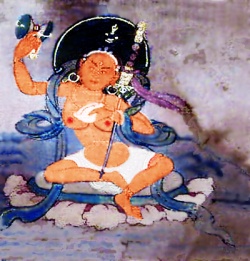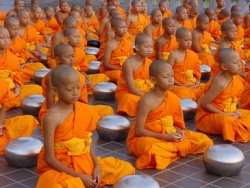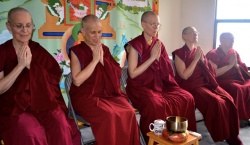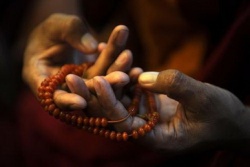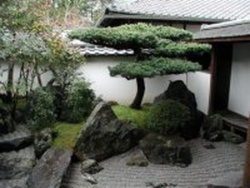Yidam
In Vajrayana Buddhism, an Ishta-Deva or Ishta-devata (Sanskrit: इष्टदेवता) (Yidam in Tibetan) is a fully enlightened being who is the focus of personal meditation, during a retreat or for Life.
The term is often translated into English as tutelary deity, meditation deity, or meditational deity.
The Ishta-Deva appears in the 'Inner' Refuge formula of the Three Roots and is also the key element of Deity Yoga since the 'deity' in the yoga is the Ishta-Deva.
Nomenclature and etymology
The Sanskrit word iṣṭadevatā or iṣṭadevaḥ is a compound of iṣṭa (desired, liked, reverenced) + devatā (a deity or divine being).
It is defined by V. S. Apte as "a favorite God, one's tutelary deity." Though this term is used in many popular Books on Buddhist Tantra, the term işţadevatā has not been attested in any Buddhist tantric text in Sanskrit. The word corresponding to this concept is adhideva, though of rare occurrence.
The unrelated Tibetan version of the term, possibly of entirely native origin, is yi-dam is said to be a contraction of Tib. yid-kyi-dam-tshig, meaning "Samaya of mind"- in other words, the state of being indestructibly bonded with the inherently pure and liberated nature of mind.
Three Roots
The Ishta-Deva appears as one of the Three Roots in the Tibetan Buddhist 'Inner' Refuge formulation. The iconography of the Ishta-Deva may be 'peaceful', 'wrathful' (Tibetan tro wa) or 'neither peaceful or wrathful'(Tibetan: shi ma tro), depending on the practitioner's own nature.
The Ishta-Deva represents awakening and so its appearance reflects whatever is required by the practitioner in order to awaken.
The Guru will guide the student as to which Ishta-Deva is appropriate for them and then initiation into the mandala of the Ishta-Deva is given by the Guru, so that Deity Yoga practices can be undertaken. In essence, the Mindstream of the Guru and the yidam are indivisible.
The yidam is considered to be the root of success in the practice.
Ishta-devatas in East Asian Buddhism
The Vajrayana traditions of China, Korea and Japan, while smaller and less prominent than Indo-Tibetan Tantric Buddhism, are characterized in part by the utilization of isha-devatas in meditation.
One promiment ishta-devata in East Asian Vajrayana is Marici (Ch: Molichitian, Jp: Marishi-ten).
In the Shingon tradition of Japan, prominent isha-devatas include the "five mysteries of Vajrasattva," which are
Vajrasattva (Jp. Kongosatta),
Surata/Ishta-vajrinī (Jp. Yoku-kongonyo "慾金剛女"),
Kelikilā-vajrinī (Jp. Shoku-kongonyo "触金剛女"), Kāmā/Rāga-vajrinī ((Jp. Ai-kongonyo "
愛金剛女"), and
Kāmesvarā/Mana-vajrinī ((Jp. Man-kongonyo "慢金剛女").
Ishta-devatas in Nepalese Newar Buddhism
The principal ishta-devetas in the Newar Vajrayana tradition of Nepal are Chakrasamvara and Vajravarahi.
In that tradition, three components are essential to a temple complex:
a main shrine symbolizing Svayambhu Mahachaitya;
an exoteric shrine featuring Buddha Shakyamuni and other Buddhas and bodhisattvas;
and an esoteric shrine dedicated to the ishta devatas, to which only initiates may be admitted.
Working definition
According to The Tonglen and Mind Training Site which discusses Tonglen and Ngöndro, Yidam is:
Visualized representative of your enlightened energy, or Buddha-nature.
Tricky concept for Westerners; closest concept might be that of a patron saint in Catholicism, except that a yidam is not a historical figure and is not necessarily supposed to 'exist' in the same way human beings do.
Other related concepts might be a totem or Power animal in the Native American tradition, or even the fairy godmother in children's tales.
Brennan (2006) draws a comparison between Ishta-devas and "tulpas", Tibetan spirits, (Tibetan) and uses the English rendering "thoughtform".
The sacred architecture of their instrumentation, the magic circle, is (Tibetan: kylkhor; kyil khor).
Exegesis
During the (meditation) practice of the generation stage, a practitioner (sadhaka) establishes a strong familiarity with the Ishta-Deva (an enlightened being) by means of visualization and a high level of concentration.
During the practice of the Completion stage, a practitioner focuses on methods to actualize the transformation of ones' own Mindstream and Body into the meditation Deity by meditation and yogic techniques of energy-control such as kundalini (tummo in Tibetan). Through these complementary disciplines of generation and completion one increasingly perceives the pervasive Buddha nature.
Judith Simmer-Brown summarises:
... a yidam, a personal meditational deity, a potent ritual symbol simultaneously representing the mind of the Guru and lineage of enlightened teachers, and the enlightened mind of the tantric practitioner. Recognizing the inseparability of these two is the ground of tantric practice.
Berzin (1997: unpaginated) in discussing Buddhist Refuge commitment and Bodhisattva vows frames a caution to sadhana:
More specifically, this commitment means not taking ultimate Refuge in gods or spirits.
Buddhism, particularly in its Tibetan form, often contains ritual ceremonies, or pujas, directed toward various Buddha-figures or fierce Protectors in order to help dispel obstacles and accomplish constructive purposes.
Performing these ceremonies provides conducive circumstances for negative potentials to ripen in trivial rather than major obstacles, and positive potentials to ripen sooner rather than later.
If we have built up overwhelmingly negative potentials, however, these ceremonies are ineffective in averting difficulties.
Therefore, propitiating gods, spirits, Protectors or even Buddhas is never a substitute for attending to our Karma – avoiding destructive conduct and acting in a constructive manner.
Buddhism is not a spiritual path of protector-worship, or even Buddha-worship.
The safe direction of the Buddhist path is working to become a Buddha ourselves.
In the Vajrayana practices of Tibetan Buddhism, 'safe direction', or 'Refuge' is undertaken through the Three Roots, the practitioner relying on an Ishta-Deva in Deity Yoga as a means of becoming a Buddha.
Common yidams
Some common Ishta-devas include
Hayagriva,
Vajrakilaya (Dorje Phurba),
Samputa,
Guhyasamaja,
Yamantaka,
Hevajra,
Kurukulle,
Cakrasamvara,
Vajrayogini, and
Kalachakra.
Also, other enlightened beings such as the regular forms of the Buddhas,
Bodhisattvas,
Padmasambhava,
certain Dharmapalas,
Dakinis,
Wealth Deities, and Yab-Yum representations, among others, can also be practiced as an ishta-Deva.
Avalokiteshvara,
Tara,
Manjusri,
Hevajra and consort Nairatmya,
Heruka-Chakrasamvara and consort Vajravarahi,
etc. are frequently chosen as Ishta-devas, but any deity of the tantric pantheon may be adopted as such.
The Ishta-Devata is used as a means or a goal of transformation towards full Enlightenment.
According to certain traditions, the Ishta-devas are considered as the emanation of the adept's own mind.
Ishta-devas with accoutrements and attributes
Center
Element: Ether
Chief Buddha: Vairochana
Consort: Dharma-Dhatu
Color: White
Enemy: Stupidity
Virtue: All-accommodating, embodiment of Emptiness
East
Element: Water
Chief Buddha: Vajrasattva
Consort: Mamaki
Color: Blue
Enemy: Violent Anger
Virtue: Mirror-like Wisdom
Accompanying Bodhisattvas: Kshitigarbha, Lasema, Maitreya, Pushpema
South
Element: Earth
Chief Buddha: Ratnasambhava
Consort: Sang-Yay Chan-ma
Color: Yellow
Enemy: Egotism
Virtue: Equality
Accompanying Bodhisattvas: Akasha Garbha, Mahlaima, Samantabhadra, Dureme
[[File:HL.jpg |thumb|250px|]]
West
Element: Fire
Chief Buddha: Amitabha
Consort: Cokarmo
Color: Red
Enemy: Attachment
Virtue: Discrimination
Accompanying Bodhisattvas: Chanrazee, Chirdhima, Jampal, Aloke
North
Element: Air
Color: Green
Chief Buddha: Amoghasiddhi
Consort: Dolma
Color: Green
Enemy: Jealousy
Virtue: All-performing Wisdom
Accompanying Bodhisattvas: Chag-na-Dorje, Gandhema, Dibpanamsel, Nidhema
When we consider all the great masters of the Indian and Tibetan traditions, we find that in every case, their accomplishment came about through their practice of a yidam.
They chose a deity and guarded that practice like their very life force, and on the basis of that complete commitment to the path of deity yoga, they practised the stage of generation, the stage of completion, and integrated these arriving at their final realisation of complete accomplishment and enlightenment.
But nowadays there are people who say, “Oh, what a lot of bother! Deities and mantra, I hate all that. I’m just going to meditate.”
And they sit there, and close their eyes, and that’s what they call practice.
They say, “I just want to do effortless meditation.”
But as Dilgo Khyentse Rinpoche said, “Although there are people like that, I’ve not seen them gaining any sign of attainment.”
In one of the texts of Ratna Lingpa’s cycle of Vajrakilaya practice, there is a passage which recounts how on one occasion Yeshe Tsogyal asked Guru Rinpoche about the nature of kyérim practice.
“Do we really need a yidam deity?”, she questioned. Guru Rinpoche replied, “If there is no yidam, where is the source of siddhis? Without siddhi, how could there be enlightenment?”
In fact, if we look at the great masters of the Indian and Tibetan traditions of Vajrayana practice, we find there is no-one who did not meditate upon a yidam deity.
In the Nyingmapa school, all the great vidyadharas have had a main yidam deity which they practiced. If their practice was of a peaceful deity, it was almost always Vajrasattva.
If it was a wrathful deity, it was almost always Vajrakilaya. Guru Rinpoche and Vimalamitra themselves attested to the fact that Vajrakilaya was their yidam deity.
Nowadays however, the Nyingmapas are perhaps the worst when it comes to practising a yidam on a daily basis.
When Jamyang Khyentse Chökyi Lodrö was giving the Rinchen Terdzö empowerment, he scolded us as Nyingmapa practitioners and said,
“You Nyingmapas don’t do any kind of regular daily practice.
You don’t even say the Sampa Lhundrupma prayer; you just lie around all day!
We Sakyapas must do the path empowerment practice of Hevajra every day , which takes about two or three hours.
You don’t do anything. You just lie around. You don’t do any kind of regular practice.”
He said to us, “If you want yidam deities, you Nyingmapas have more than anybody.”
He showed us all the texts of the Rinchen Terdzö, which consists of dozens and dozens of volumes, and said,
“This is filled with sadhanas of the three roots—lama, yidam and dakini—but none of you practises any of them.”
What he said was true. Perhaps the reason is that so many of us in the Nyingma tradition place great emphasis on the Dzogchen tradition and its effortlessness.
Often we make the mistake of just paying lip service to effortlessness, while really just being kind of lazy.
Look at someone like Kyabje Dilgo Khyentse Rinpoche.
No-one would question that his realisation was higher than anyone’s, and yet day and night he would recite prayers and mantras and do his practice.
And he was inseparable from Vimalamitra!
Look at the kind of effort that he put into his practice.
Then there are others who just don’t do very much of that at all.
They just sit there with their mouths open.
On one occasion, I asked Dilgo Khyentse Rinpoche, “Is it necessary for someone with realization to recite prayers and mantras?”
And he replied,
“Someone who has that kind of realisation is like space.
What harm could recitation possibly do to space?”And he continued,
“To recite even a single mani mantra, or to recite the Vajra Guru mantra a few times, is only going to help. It’s not going to hurt, is it?”
